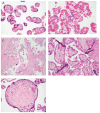Avascular villi, increased syncytial knots, and hypervascular villi are associated with pregnancies complicated by factor V Leiden mutation
- PMID: 20121426
- PMCID: PMC3161512
- DOI: 10.2350/09-05-0657-OA.1
Avascular villi, increased syncytial knots, and hypervascular villi are associated with pregnancies complicated by factor V Leiden mutation
Abstract
There is controversy about whether pathologic abnormalities are associated with pregnancies complicated by factor V Leiden (FVL) mutation. The purpose of this study was to evaluate 105 placentas delivered to mothers heterozygous for FVL mutation to determine if there are pathologic changes suggestive of hypoxia or thrombosis, which correlate with mutation status. We examined placentas obtained as part of a prospective study of 5188 pregnancies analyzed for the presence of FVL mutation in either the mother or the infant. One hundred five placentas from mothers heterozygous for the mutation were compared with 225 controls matched for maternal age, race, and geographic site. Of the 330 pregnancies, 50 infants were FVL mutation heterozygotes. Maternal FVL heterozygote status was associated with more frequent increased numbers of syncytial knots (13% vs 4%); the difference remained significant after controlling for hypertension, preeclampsia, small-for-gestational-age infants, and delivery prior to 35 weeks of gestation (odds ratio 3.6, 95% confidence interval 1.5-8.7, P = 0.004). Maternal FVL heterozygotes had more hypervascular villi (10% vs 3%), with significance retained controlling for delivery route (odds ratio 3.4, 95% confidence ratio 1.2-9.4, P = 0.018). Placentas from infants heterozygous for FVL mutation had more avascular villi than controls (odds ratio 2.9, 95% confidence interval 1.5-5.6, P = 0.001). Fetal or maternal FVL heterozygosity was not associated with infarcts, small-for-gestational-age placentas, or fetal thrombotic vasculopathy. This analysis demonstrates that pathologic findings associated with placental hypoxia, specifically focal avascular villi, increased numbers of syncytial knots, and hypervascular villi, also correlate with FVL heterozygosity in infants or mothers.
Figures
Similar articles
-
Frequency of factor V(Leiden) and prothrombin G20210A in placentas and their relationship with placental lesions.Hum Pathol. 2000 Sep;31(9):1036-43. doi: 10.1053/hupa.2000.16281. Hum Pathol. 2000. PMID: 11014568
-
Peripartum thromboprophylaxis for homozygous and heterozygous FVL mutation carriers yields similar pregnancy outcome.Isr Med Assoc J. 2014 Feb;16(2):96-100. Isr Med Assoc J. 2014. PMID: 24645228
-
Homozygous factor V Leiden and double heterozygosity for factor V Leiden and prothrombin mutation.J Thromb Thrombolysis. 2013 Oct;36(3):324-31. doi: 10.1007/s11239-012-0824-5. J Thromb Thrombolysis. 2013. PMID: 23054468 Clinical Trial.
-
Genetic Testing for Thrombophilia-Related Genes: Observations of Testing Patterns for Factor V Leiden (G1691A) and Prothrombin Gene "Mutation" (G20210A).Semin Thromb Hemost. 2019 Oct;45(7):730-742. doi: 10.1055/s-0039-1694772. Epub 2019 Aug 9. Semin Thromb Hemost. 2019. PMID: 31398733 Review.
-
Recommendations from the EGAPP Working Group: routine testing for Factor V Leiden (R506Q) and prothrombin (20210G>A) mutations in adults with a history of idiopathic venous thromboembolism and their adult family members.Genet Med. 2011 Jan;13(1):67-76. doi: 10.1097/GIM.0b013e3181fbe46f. Genet Med. 2011. PMID: 21150787
Cited by
-
Placental Structure in Preterm Birth Among HIV-Positive Versus HIV-Negative Women in Kenya.J Acquir Immune Defic Syndr. 2019 Jan 1;80(1):94-102. doi: 10.1097/QAI.0000000000001871. J Acquir Immune Defic Syndr. 2019. PMID: 30272633 Free PMC article.
-
The association between IUGR and maternal inherited thrombophilias: A case-control study.Medicine (Baltimore). 2018 Oct;97(41):e12799. doi: 10.1097/MD.0000000000012799. Medicine (Baltimore). 2018. PMID: 30313110 Free PMC article.
-
Case report: Umbilical vessel aneurysm thrombosis and factor V Leiden mutation leading to fetal demise.Front Med (Lausanne). 2023 Jan 4;9:1083806. doi: 10.3389/fmed.2022.1083806. eCollection 2022. Front Med (Lausanne). 2023. PMID: 36687456 Free PMC article.
-
Associations between Maternal and Fetal Inherited Thrombophilias, Placental Characteristics Associated with Vascular Malperfusion, and Fetal Growth.TH Open. 2017 Jun 28;1(1):e43-e55. doi: 10.1055/s-0037-1603925. eCollection 2017 Jun. TH Open. 2017. PMID: 31249910 Free PMC article.
-
Heparin rescues factor V Leiden-associated placental failure independent of anticoagulation in a murine high-risk pregnancy model.Blood. 2013 Mar 14;121(11):2127-34. doi: 10.1182/blood-2012-08-448209. Epub 2013 Jan 16. Blood. 2013. PMID: 23325830 Free PMC article.
References
-
- Dahlbäck B. Advances in understanding pathogenic mechanisms of thrombophilic disorders. Blood. 2008;112:19–27. - PubMed
-
- Levy RA, Avvad E, Oliveira J, Porto LC. Placental pathology in antiphospholipid syndrome. Lupus. 1998;7(suppl 2):S81–S85. - PubMed
-
- Abramowsky CR, Vegas ME, Swinehart G, Gyves MT. Decidual vasculopathy of the placenta in lupus erythematosus. NEJM. 1980;303:668–672. - PubMed
-
- Redline RW. Thrombophilia and placental pathology. Clin Obstet Gynecol. 2006;49:885–894. - PubMed
-
- Vern TZ, Alles AJ, Kowal-Vern A, Longtine J, Roberts DJ. Frequency of factor V Leiden and prothrombin G20210A in placentas and their relationship with placental lesions. Hum Pathol. 2000;31:1036–1043. - PubMed
Publication types
MeSH terms
Substances
Grants and funding
- HD36801/HD/NICHD NIH HHS/United States
- HD27861/HD/NICHD NIH HHS/United States
- UG1 HD027869/HD/NICHD NIH HHS/United States
- HD34136/HD/NICHD NIH HHS/United States
- U10 HD034136/HD/NICHD NIH HHS/United States
- U10 HD034210/HD/NICHD NIH HHS/United States
- U10 HD034116/HD/NICHD NIH HHS/United States
- U10 HD027860/HD/NICHD NIH HHS/United States
- HD27915/HD/NICHD NIH HHS/United States
- U01 HD036801/HD/NICHD NIH HHS/United States
- UG1 HD034116/HD/NICHD NIH HHS/United States
- HD27869/HD/NICHD NIH HHS/United States
- HD27860/HD/NICHD NIH HHS/United States
- UG1 HD027915/HD/NICHD NIH HHS/United States
- HD21414/HD/NICHD NIH HHS/United States
- U10 HD027905/HD/NICHD NIH HHS/United States
- U10 HD027861/HD/NICHD NIH HHS/United States
- UG1 HD034208/HD/NICHD NIH HHS/United States
- HD34210/HD/NICHD NIH HHS/United States
- HD21410/HD/NICHD NIH HHS/United States
- U10 HD027869/HD/NICHD NIH HHS/United States
- U10 HD027917/HD/NICHD NIH HHS/United States
- HD34116/HD/NICHD NIH HHS/United States
- U10 HD034122/HD/NICHD NIH HHS/United States
- U10 HD021414/HD/NICHD NIH HHS/United States
- U10 HD027915/HD/NICHD NIH HHS/United States
- U10 HD034208/HD/NICHD NIH HHS/United States
- HD34208/HD/NICHD NIH HHS/United States
- HD27917/HD/NICHD NIH HHS/United States
- U10 HD021410/HD/NICHD NIH HHS/United States
- U10 HD036801/HD/NICHD NIH HHS/United States
- U24 HD036801/HD/NICHD NIH HHS/United States
LinkOut - more resources
Full Text Sources


